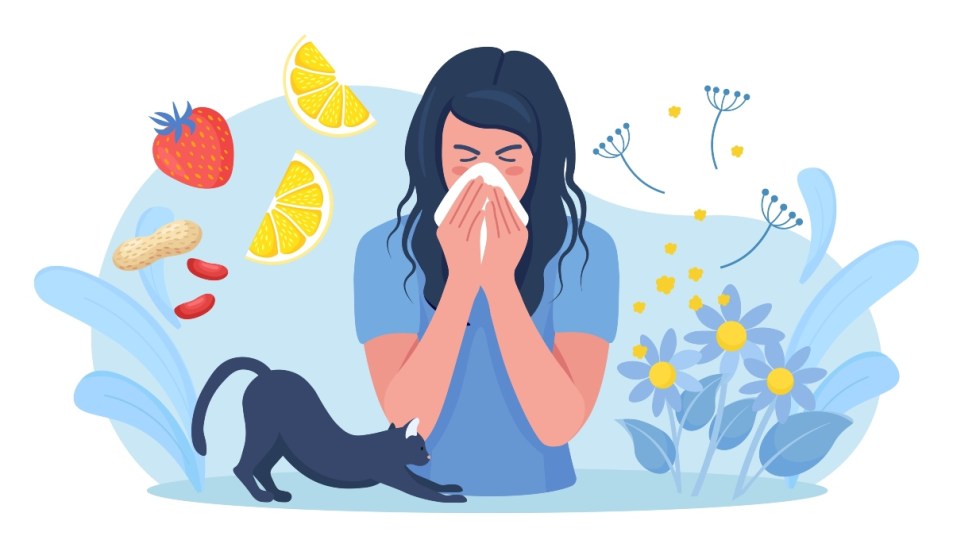Don’t Let Your Seasonal Sniffles and Allergies Go Untreated — It Could Have Long-Term Effects
Get ahead of those springtime sniffles.

Ah, spring. No matter where you live, it’s the season of renewal, sunshine, milder weather — and plenty of allergies. Those seasonal sniffles may arrive on top of other allergies as well, such as to certain foods or substances. As you try to calm it all down, your inflammation levels soar.
When allergies flare up, no matter what kind they are, you’re experiencing the acute type of inflammation. This can prompt a range of symptoms from annoying to severe, including congestion, redness, swelling, heat and pain, all the way up to shortness of breath and dizziness. Even if your symptoms are tolerable, it’s important to treat them and avoid triggers. If they drag on, you’ll be at higher risk for chronic inflammation, since unresolved acute inflammation can lead to tissue damage over time, especially in your sinuses and airways. You’ll also be at higher risk for systemic inflammation; long-term, you may start seeing things like fatigue, joint pain, weight gain, and headaches happening, not to mention heart disease and diabetes.
“The best strategy is to notice signs of acute inflammation that are connected to allergies because they’re more treatable and less dangerous at that stage,” says Bindiya Gandhi, MD, an Atlanta-based functional medicine physician. “When you start dealing with chronic inflammation, that’s when symptoms become more severe and take longer to treat.”
Your Body on Allergies
According to the American Academy of Allergy, Asthma & Immunology, about 50 million Americans suffer from some form of allergic disease, and that number is most likely going to keep increasing. Allergies come in multiple forms, including pollen, pet dander, mold, food, bee venom, latex, and dust mites. Certain medicines like antibiotics, ibuprofen, or aspirin can also cause allergic reactions.
No matter what the cause, the effect tends to be fairly similar, even though some underlying mechanisms may be unique to each allergy type, says Tania Mucci-Elliott, MD, an allergist and immunologist at NYU Langone Health. “Your body sees the allergen as a threat, and your immune system increases your inflammatory response to deal with that,” she says. “What differs is how that inflammation is used, depending on what the allergen might be.” Here’s the process behind three common types of allergic reactions:
Airborne Substances Like Pollen
When you come in contact with or breathe in allergens, antibodies called Immunoglobulin E (IgE) travel to affected cells like those in your nose, mouth, lungs, and eyes, and release chemicals designed to flush out the invader. That can lead to symptoms like increased mucus in the lungs, runny nose, and watery, itchy eyes.
Contact Dermatitis
When an allergen or irritant, such as poison ivy, latex, or household chemicals, comes into contact with the skin, small molecules called haptens penetrate the outer skin layers and mix with skin proteins to create what’s called an active antigen. Your immune system recognizes this as a threat and sends out T-cells, which can use inflammation as a way to fight back. The result: Itching, redness, swelling, and blistering of the skin that aren’t an IgE-mediated response.
Food Allergies
When your allergy is related to a specific food, your immune system is usually being triggered by a particular protein in that food. You can experience a reaction after exposure to only a small amount and you’ll always have a reaction every time you eat it. Similar to other allergens, the immune system produces IgE antibodies, which can cause a cascade of effects like hives and swelling, particularly around the mouth, neck, and face. The most common food allergies are to shellfish, milk, eggs, peanuts, wheat, tree nuts (like walnuts and cashews), soy, and fish. If you have a minor reaction, like feeling uncomfortable or getting a slight headache, it’s more likely that you have a sensitivity to that food, not an allergy, but your doctor can help you figure out the difference.
All of these reactions send acute inflammation soaring, and that sometimes includes within the respiratory system, Mucci-Elliott says. That’s why some people may have frightening symptoms like difficulty breathing. In severe cases, the inflammation can be so overwhelming that it may cause anaphylaxis, a condition where the throat constricts, and there’s shortness of breath, weakened pulse, and possible loss of consciousness.
As You Age
Some allergies appear in childhood, but they can develop at any time. About one in five people with food allergies see the problem begin in adulthood, says Christopher Warren, PhD, assistant professor of epidemiology at Northwestern Feinberg School of Medicine in Chicago.
“Because people may have been eating these foods for years or decades without a problem, they may not connect an allergy response to what they’re eating, and that can increase inflammation over time,” he says.
In addition, it can be hard to distinguish between an allergy and an intolerance. Subtle symptoms such as bloating, low-level itchiness, congestion, headaches, and brain fog are typical of intolerances or sensitivities, which are not the same as an allergic reaction — yet. According to the Academy of Nutrition and Dietetics, food intolerances usually occur due to a lack of an enzyme needed to digest certain foods, or sometimes as a reaction to additives or other compounds in it.
Over time, though, your intolerance may turn into an allergy and symptoms can become more severe like nausea, vomiting, stomach cramps, hives, and diarrhea. Not every intolerance turns into an allergy, but it’s helpful to know that some can.
“The factors for adult-onset allergies aren’t clear, but they may be a result of hormonal changes, effects of viral infections, or other allergies compromising the immune system,” Warren says. In other words, one allergy may raise your risk of developing another.
Aging can also exacerbate allergies. A 2017 study in Aging & Disease found that food allergies are very common in the elderly. Their aging (less responsive) immune responses, reduced stomach acid, micronutrient deficiencies, and altered gut microbiota all help set the stage for new allergies.
Minimizing Reactions
If you experience occasional allergies and treat symptoms accordingly, the risk of an expanding allergic response is lower, Warren says. Keep in mind that your initial allergic response is actually beneficial, because it’s your immune system trying to repel a perceived threat. But as that threat continues and the immune system can’t clear it, that’s when you might shift toward a longer-term issue. No matter what type of allergies you’re facing, putting strategies in place that help lower the risk of a flare-up can also keep your inflammation levels in check.
Tips and Tricks
- Stock Your Medicine Cabinet: Keeping antihistamines and anti-inflammatory medications on hand and taking them at the first sign of an allergic reaction helps your immune system so it doesn’t have to work as hard, Warren says.
- Stay Indoors: On high-pollen days, limit outdoor time and use air conditioning instead of having windows open.
- Use Air Filters: There’s a reason you should keep those filters that fit into your air conditioner or furnace clean. Besides keeping dust out of your system, they can also filter out some allergens — if you get the right kind. Look for a high-efficiency filter with a MERV rating of 7 to 11 (it’ll cost more).
- Clean Your Home: Especially if you have pets, a regular dusting and vacuuming routine is crucial.
- Skip Scents: Use skincare products and house cleaners that don’t have fragrance, since that’s the main culprit with contact dermatitis.
- Avoid Trigger Foods: That hunk of brie is so tempting but skip those foods that trigger allergy or sensitivity symptoms.
If your symptoms are getting worse or you can’t seem to pinpoint the cause of your allergies, it’s worth a visit to your doctor or an allergist for testing. Also, keep track of your triggers. Being allergy-savvy will help lower your immune response and inflammation levels over time.
The Ins and Outs of Allergy Testing
If you have symptoms like fatigue, mild headaches, skin irritation, and runny nose, allergies might be at play. But how do you find out? Your doctor may recommend allergy tests, which come in two forms:
- Skin: With this type of test, your skin is exposed to suspected allergens, such as pollen and pet dander, and the skin is pricked. If that small patch of skin becomes inflamed as your immune system launches an attack, it signals that you’re allergic to the substance, although there can be false positives. Further testing and a convo with your doctor will help flesh out the entire picture, says Bindiya Gandhi, MD.
- Blood: These measure the amount of allergen-specific antibodies like IgE in your blood. They’re often for diagnosing food allergies but can also screen for allergens such as dust and mold.
Skin tests tend to be the preferred method of allergy testing, but blood tests are used when someone has a skin condition, can’t tolerate the needle scratches that are part of skin testing, or has a history of strong reactions to skin tests.
A version of this article appeared in our partner magazine, The Complete Guide to Anti-Inflammation.













